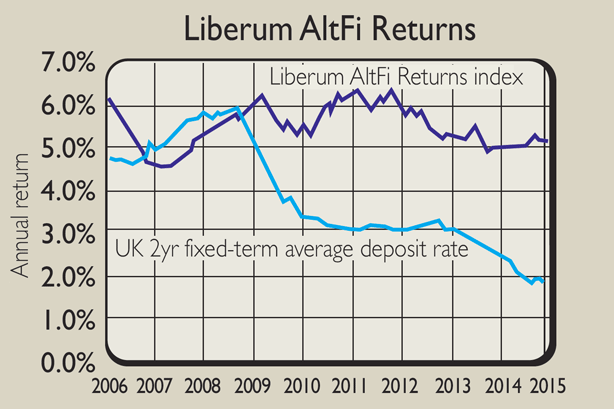Peer-to-peer lending is all very trendy – but should we buy it?
Peer-to-peer lending generates a lot of hype. David C Stevenson looks at the numbers to see if investors are right to be excited.

The numbers are in, and they're looking good.
The alternative-finance industry in general and peer-to-peer (P2P) lending in particular makes a big noise about publishing its data. And the big platforms, such as Zopa, RateSetter and Funding Circle are paragons of transparency.
Yet industry-wide, once one cuts through the hype particularly within crowdfunding, where useful numbers are very hard to come by there's a dearth of sensible benchmarks that allow you to compare P2P lending yields against those of savings accounts and bonds, for example.
MoneyWeek
Subscribe to MoneyWeek today and get your first six magazine issues absolutely FREE

Sign up to Money Morning
Don't miss the latest investment and personal finances news, market analysis, plus money-saving tips with our free twice-daily newsletter
Don't miss the latest investment and personal finances news, market analysis, plus money-saving tips with our free twice-daily newsletter
There are plenty of numbers on total transactions. My colleagues at AltFi Data can tell you that, in terms of volume of loans by platforms, around £783m has been lent to small businesses and £630m to consumers in the last 12 months. Zopa and RateSetter in consumer lending, and Funding Circle and MarketInvoice in small business lending, dominate these numbers with a market share of more than 72%.
But newer players, such as Wellesley & Co and LendInvest, loaned a lot in 2014 £140m and £152m respectively. And those numbers don't factor in future growth in newish platforms, such as AssetzCapital.
But these numbers only tell you who's been lending, not the yield you'd have received as an investor, which is the number we want. One answer is to go to the platforms concerned and pluck out their "gross" or (better) "net" rates (after defaults).
Zopa currently projects 5.1% for five years, and 4% for three years, while RateSetter has five years at 6.1%, three years at 4.8% and one year at 3.4%. Average net returns for Funding Circle are likely to be around 6.9%, with most of its loans lurking around the three-year range.
So for three to five-year money, one can reasonably expect a return of 4%-6.9% from these platforms. But these numbers only give a snapshot based on average headline rates. They don't tell you how those numbers have evolved or much at the granular level, ie, loan-by-loan cash-flow rates over time. This matters, as it gets to what investors need to know.
Bond investors are used to understanding returns in terms of cash flows, which incorporate yields to maturity, defaults netted off against income, and bond-by-bond payment cash flows (those coupon payments). Once these data are fed into a model, we can estimate a bond's return against benchmarks.
These kind of data haven't been available for P2P until now. My colleagues at AltFi Data have spent much of the last year getting three key pioneering platforms (Zopa, RateSetter and Funding Circle) to give them their loan-by-loan data. They've then fed these into a database model that has given them the Liberum AltFi Data Returns index (Lari).

The chart on the rightshows how that return has evolved over time the trailing 12-month return has varied between 4.5% and 6.2% for the last nine years (pre-2011, these returns were only for Zopa, as RateSetter and Funding Circle hadn't begun lending yet).
How does this compare to other investments? P2P lending has its risks borrowers sometimes default so it's not really fair to compare this yield with the yield on two-year government bonds (gilts) currently just 0.57%.
A better comparison may be with corporate bonds, where there's a greater chance of default and no chance of compensation from the Financial Services Compensation Scheme (FSCS).
Look at Hargreaves Lansdown's bond website and you'll see that most reputable two-year bonds pay around 1%-1.5% a year. BG Transco yields 1% and Scottish Power pays out 1.3%. As for savings products, two-yearbonds currently average around 2%-2.2%, with three-year rates at 2.5%.
I've used two years as an average because, once you incorporate the fact that even three-year P2P loans are repaid on a monthly amortising basis, the average "duration" (the point at which a bond has repaid its purchase price through its coupon payouts) across most P2P platforms is probably closer to two years than three.
The upshot is that investors are being paid an extra 2.5%-3.5% a year for taking the greater risk of investing in P2P platform products. Now, this rate can and almost certainly will change in the future especially if interest rates start to rise. If that happens, income yields across the board will rise. At that point, traditional FSCS-backed savings products might become very competitive with P2P although the hard numbers suggest otherwise.
Big banks and building societies don't tend to raise their rates fast. The Lari numbers suggest that P2P lenders will be more nimble (as the chart shows). To give one example, from early 2006 to late 2008, Zopa's gross lending rate went from 3.9% to 9.6% a year a 5.6 percentage point jump. By comparison, two-year fixed-rate deposit accounts went from 4.6% to 5.9%.
Lari is a valuable tool for investors, but much more information is needed. We need to understand the risk side of the equation (especially defaults, which I'll return to next month) and we need more of the smaller platforms to hand over their data. We also need to see what impact increased interest rates and a business slowdown will have on net returns over the next few years before we can really call alternative finance a mainstream option.
One last thought. Perhaps the most dynamic alternative-finance platform of recent months has been AssetzCapital. Barely a month goes by without some new deal or product being announced last month it revealed a tie-up with a major US invoice-funding platform that'll be feeding lending opportunities to Assetz's UK investors. But perhaps the most interesting news is that the platform has decided to use the crowd to fund its next stage of development.
Many in the City had expected Assetz to go for a public listing a route favoured by the likes of LendInvest, which plans to list later in the year but it seems Assetz is sticking to its alternative-finance roots and is looking to raise money through crowd-equity platform Seedrs, which has played host to a number of great investment opportunities in recent months.
If we measure an investment opportunity by sheer momentum, I'd consider putting some money into Assetz's fund raising via Seedrs. The initial target was to get £2m in the door, but that was quickly hit and now the level's been raised to £3m. The structure is a bit more complex than normal as you're buying into a convertible structure where the valuation is a minimum of £25m and a maximum of £60m.
The actual valuation is finalised when the first institutional investor puts in more than £1m over the next 24 months. The Seedrs investors then get a 10% discount on that future price (or 20% if it takes longer than 24 months), represented as bonus shares, and their bid converts to ordinary shares. The minimum investment via Seedrs is £10.
I suspect Assetz will move quite quickly to list on, say, Aim, using benchmarks like Lending Club's US initial public offering as an indicative valuation.
This US platform was floated at one times loan origination if one uses that rough and ready guideline, a valuation in the £25m-£60m range doesn't look bonkers, although Assetz will have to step up a gear in terms of loan flows and new customers to justify such lofty valuations.
Read more about alternative finance at my website, www.altfi.com.
Get the latest financial news, insights and expert analysis from our award-winning MoneyWeek team, to help you understand what really matters when it comes to your finances.

David Stevenson has been writing the Financial Times Adventurous Investor column for nearly 15 years and is also a regular columnist for Citywire.
He writes his own widely read Adventurous Investor SubStack newsletter at davidstevenson.substack.com
David has also had a successful career as a media entrepreneur setting up the big European fintech news and event outfit www.altfi.com as well as www.etfstream.com in the asset management space.
Before that, he was a founding partner in the Rocket Science Group, a successful corporate comms business.
David has also written a number of books on investing, funds, ETFs, and stock picking and is currently a non-executive director on a number of stockmarket-listed funds including Gresham House Energy Storage and the Aurora Investment Trust.
In what remains of his spare time he is a presiding justice on the Southampton magistrates bench.
-
 Leading European companies offer long-term growth
Leading European companies offer long-term growthOpinion Alexander Darwall, lead portfolio manager, European Opportunities Trust, picks three European companies where he'd put his money
-
 How to harness the power of dividends
How to harness the power of dividendsDividends went out of style in the pandemic. It’s great to see them back, says Rupert Hargreaves